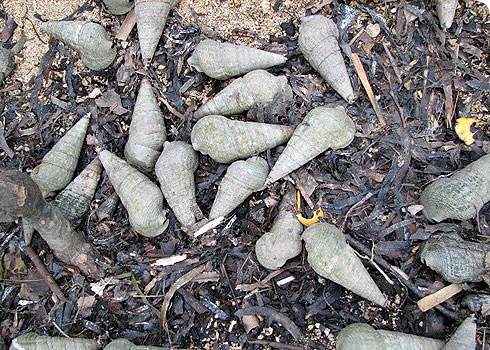Distribution
This species has a wide geographical distribution, from Kwazulu Natal in South Africa, along the coast of east Africa to the Red Sea, the Arabian Sea, India, and the whole of southeast Asia as far north as the Ryukyu Islands of Japan. In the Indian Ocean it reaches the Maldives and Mascarene Islands, and in the Pacific extends as far east as Vanuatu and New Caledonia. It occurs throughout the tropical coast of Australia.
Terebralia palustris almost always lives in association with mangrove trees:
- juveniles occur in shallow tidal pools and channels, on soft detritus-rich silt and fine mud in the shade of Rhizophora trees
- adults are more widely distributed on coarser sediments in the higher tidal levels of the forest, but again usually remain beneath trees
The adult snails can occur in large aggregations of up to 150 per square metre, which represents one of the highest levels of gastropod biomass ever recorded.
Occasionally, populations can be found in lagoons and estuaries without mangroves if accumulations of detritus and algae provide a sufficient food source.
There is a long fossil history of this species. Shells indistinguishable from living ones have been found in early Miocene deposits in the Mediterranean, where the species no longer occurs. These occurrences (about 23 million years ago) predate the subsequent (18 million years) separation of the Mediterranean from the Indian Ocean caused by the appearance of the Arabian land bridge.
